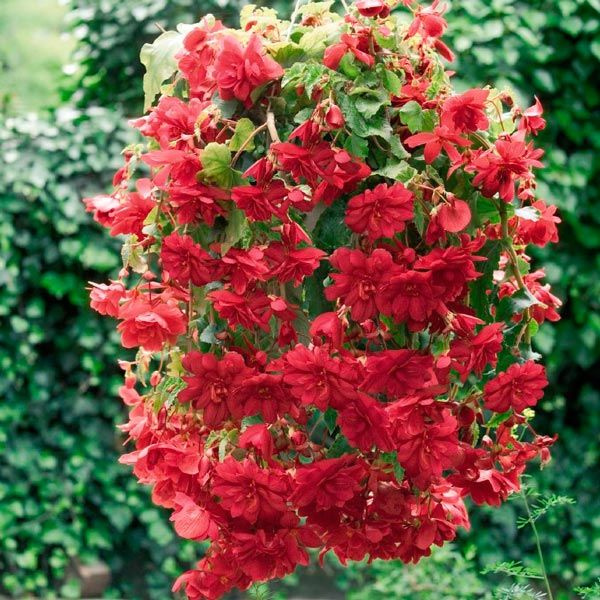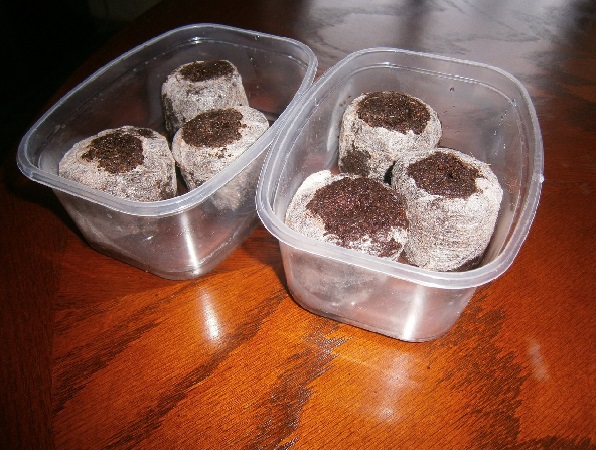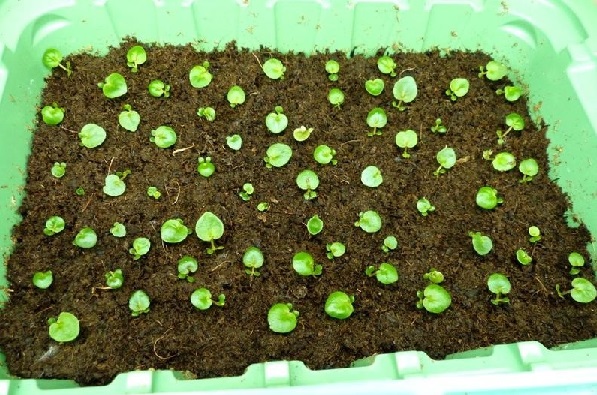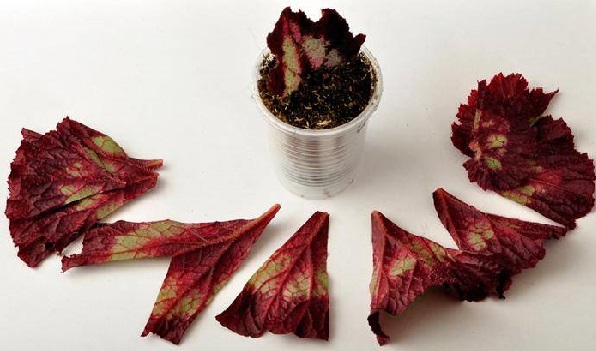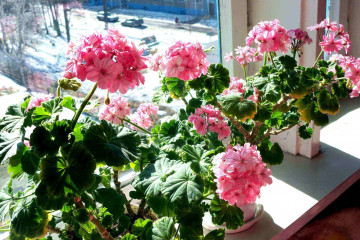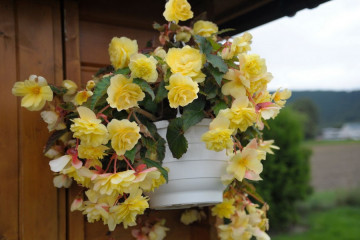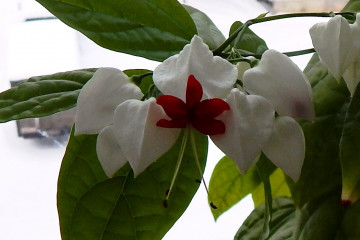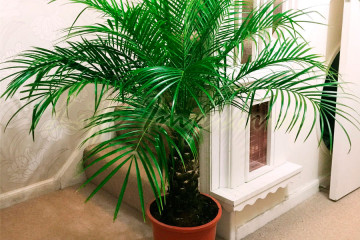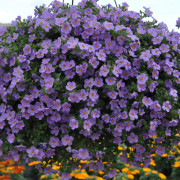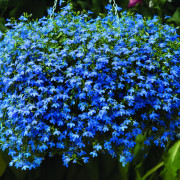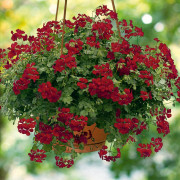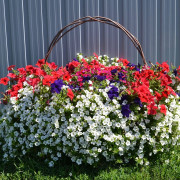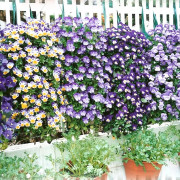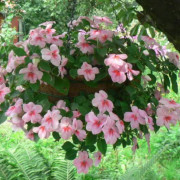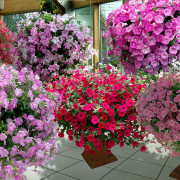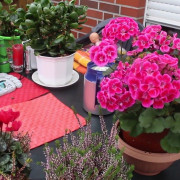How to care for ampelous begonia and form a bush
Content:
The ampelous shape of begonias is popular among flower growers who prefer undemanding crops with gorgeous asymmetrical leaves and semi-double / double flowers. Depending on the variety, the height of the ampelous begonia can be 20–60 cm, and the length of the leaves is 10–20 cm. Each flower blooms for only 10 days, but then new buds begin to bloom. Flowers can have peach, apricot, orange, snow-white, scarlet, orange-red, yellow shades.
Requirements for placement conditions
To grow a flower, you need to remember that ampelous begonias love bright light, but they do not like direct sunlight. Therefore, it is better to put them on a window shaded with tulle.
The first time they feed the culture when the shoots begin to grow. To do this, sprinkle with nitrogen, as it promotes the growth of greenery. When feeding a second time, it is advised to use special fertilizers for begonias. When buds appear and all the rest of the time, you need to take care of the flowers like this: feed 1 time in half a month, then the flowers will bloom longer.
Plants do not like low air humidity. It is better to place them close to the peat pan, which must be kept constantly moist. You should regularly spray the air from the spray bottle, but so that moisture does not get on the plants. It is worth keeping the ground moist at all times. Watered with soft and settled water.
In case of heat, be sure to spray the air near the plant. The room in which the flower stands should be ventilated from time to time, but drafts should not be allowed.
Plants are transplanted only in extreme cases.
Ampelous begonia: growing from seeds
Seeds should be sown in late February or early March.
If you bought a set of seeds in granules, then they can be planted in peat tablets. To do this, put them on a pallet and water them abundantly, they will increase in size. Then one seed should be placed in each tablet, sprinkled with water at room temperature from a spray bottle.
You can cover the tablets with polyethylene. You should not allow the earth in the tablets to dry out, you should constantly maintain humidity.
You can also place a granular seed in each cell of the container with soil, spray with water from a spray bottle and cover with polyethylene.
If the seeds are without a shell, then it is better to prepare boxes, make several holes at the bottom of each. Then pour fine crushed stone into the container, then the earth, it should have slightly acidic properties. To do this, mix 4 parts of leaf and 1 part of sod land, 1 part of sand. It is better to calcine the soil in the oven for 30 minutes.
It is recommended to thoroughly water the soil in boxes a day before sowing. Then scatter the seeds over the surface of the substrate, cover with glass or a plastic bag. You need to put the boxes in a warm place with an air temperature of + 24-25 ° C and constantly moisten the ground from a spray bottle.
Seedling care
It is best to water by placing peat tablets or crates on the tray where the water should be poured. Daylight hours should be 12-13 hours per day. If it is less, then the culture should be illuminated with fluorescent lamps. You can start hardening begonias in a week, lifting the film at first for a quarter of an hour every day.
If seedlings are grown in peat tablets, then when three true leaves appear on each plant, they are moved into a ceramic pot with earth, thoroughly watered with water. If grown in boxes, then 50 days after sowing it should be dived. This will require wide and flat ceramic pots with soil, which should be spilled abundantly and relocated in advance.
After half a month, the seedlings should be fed with fertilizer for begonias.
After about 20 weeks, the seedlings can be transplanted to a permanent place in hanging pots, planters, flowerpots and baskets. They can be placed on a balcony or loggia in the open air.
Diseases, pests
If the foliage and buds of the begonia began to fall off, this means that it lacks moisture in the soil and air.
If a whitish bloom is found on stems, foliage, it is powdery mildew. The affected areas should be cut off and the culture should be sprayed with fungicides.
If yellow spots are visible on the foliage, this means that a red spider mite attacked it. Plants are sprayed with a systemic insecticide.
Begonia ampelous: planting tubers
When winter comes, you can buy flower tubers. When buying, you should carefully consider them. The tubers should be 3 cm in diameter, healthy and intact. The concave side should have 3-6 buds.
You need to plant tubers in March, after placing them for 1 hour in a pale pink solution of potassium permanganate. Then put the convex side on a damp cloth, sand or earth and place in the light. From time to time should be sprayed with water at room temperature. When sprouts appear on the concave part of the tuber, place them in the ground.
To create a substrate, you need to mix 2 parts of leafy soil, 1 part of peat, 1 part of humus, 1 part of sand. Transfer the substrate to small pots. Place each tuber in the ground on 2/3, water and do not allow the soil to dry out in the future. When the sprouts become 10-15 cm each, the tubers can be transplanted into pots, pots. You can transplant begonia into the garden.
Ampel begonia: leaf propagation
There are three methods for leaf propagation of begonias.
The first is to cut the sheet into several pieces with a sharp knife. Each part must have at least one streak. Place parts of the leaf in pots with earth or sand, cut down. Cover with plastic wrap or plastic bottle.
Parts of the leaf should be sprayed from time to time with a spray bottle, but do not do this too often, otherwise they will rot.
When the first leaves appear after 20 days, you can harden the plant by removing the film for 15 minutes. every day, gradually increasing the time.
After 3 months, plants can be transplanted into pots, pots.
In the second method, you need to cut off a plant leaf with a 7 cm cuttings and cut it across the veins. Then place the sheet face down on wet soil, press down with stones near the cuts. Cover with plastic wrap on top and place in the sun. In the future, spray the soil with a spray bottle.
After 30 days, new begonias will grow and the film can be removed. Young grown plants will remain transplanted into pots, flowerpots.
The third way is to cut off a large leaf from the cutting and put it in a glass of water. Add 1 tablet of crushed activated carbon and root to it. If the leaf starts to rot, then you can cut it a little and replace the water. When the roots grow, you can transplant it into any container.
How to form an ampelous begonia
Planting and leaving the ampelous begonias necessarily include pruning. This is partial or complete cutting of shoots to regulate growth, development and flowering. If you cut the crop correctly, you can increase the splendor of the color and extend its life.
Crown formation:
- When a young plant reaches a height of 6-7 cm, then you can start forming a crown. To do this, cut off its top with scissors. This stimulates the intensive growth of the lateral shoots of the crop. After pruning, the number and volume of watering should be reduced so that the plants begin to grow faster.
- The next time you have to cut it when the side shoots grow up to 10 cm in length. You need to cut it over the bud located on the outside of the shoot. After that, you can cut off the most overgrown or dry shoots.
When cropping is required:
- inflorescences are cut off in decorative-leaved begonias;
- when the leaves or stems dry, they are cut off so that the begonia does not get sick;
- young begonias are cut off;
- pruning is carried out for the winter.
When to prune plants for the winter
For the winter, only tuberous begonias are cut, it is better to do this in October. If you skip this point, the foliage and buds will grow smaller and the stem thicker.
Care after pruning
After pruning, the plant should be kept at an air temperature of + 13-22 ° C and an air humidity of 60%. Begonia is dormant from October to February. At this time, you need to reduce watering, cut off the dried stems, you can water after the top layer of the soil has completely dried out. It is recommended to place the pot on a tray with moistened peat.
Do I need to pinch the ampelous begonia
Pinching is cutting off the tops of the stems and buds at the end of the branches. Pinch in spring or autumn, that is, before budding or after flowering. It should be pinched if it is not possible to trim the crop.
How to pinch an ampelous begonia
You need to pinch like this: on the main shoot, find the upper growth point and cut it by 1-2 cm. If the pinching was done correctly, then after 2-3 weeks the lateral shoots will begin to grow intensively.
Ampelous begonia, planting and caring for which at home does not cause any difficulties - a very beautiful flower. Pruning and pinching are important and necessary actions that increase the splendor of the flowering and decorative effect. Begonia has a unique charm, thanks to which it will serve as an excellent decoration for an apartment.
